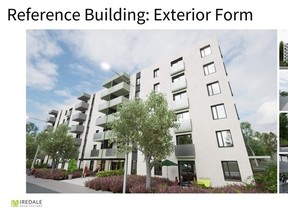The idea is to streamline design and draft common regulations to cut construction time by at least a third

Article content
When you think of new construction in Metro Vancouver, you think of concrete towers with glass facades.
A Metro Vancouver report on rental housing is considering a different approach: Making it easier to build six-storey apartment buildings out of wood.
The report’s name is a mouthful, “Streamlining the Delivery of Rental Housing Through Pre-Approved Plans and Off-Site Construction.”
Advertisement 2
Article content
But it has a simple goal: making rental housing cheaper to build.
Concrete buildings typically cost 20 to 24 per cent more to build than wooden ones. So the report, which will probably go to Metro in January, calls for low-rise wood frame buildings.
The report also wants to make it easier to build.
“We’re collaborating with B.C. Housing on (ways) to essentially speed up the delivery of six-story rental wood frame apartments,” said Michael Epp, director of housing, planning and development at Metro Vancouver.
“One of the key ones is trying to harmonize some of the regulatory approaches for that type of building.”
Building regulations vary from city to city. Going through the bureaucratic process can be time consuming — Epp said it usually takes five years from “conception to occupancy” to build a wood-frame apartment building in Metro Vancouver.
“Our short-term goal is to try to bring that time down by at least 30 per cent,” he said.
“But I think it’s possible, in an ideal state, to cut 50 per cent of that delivery time. So going from five years from start to finish to a 2½-year start to finish.”
Article content
Advertisement 3
Article content
The idea is to draft regulations for these buildings that essentially pre-approve them, cutting out the need for time-consuming rezoning applications, and to also allow for some prefabrication of the buildings in factories.
“Time is a really substantial component of (building) cost, whether or not you’ve got land carrying costs during that entirety of that time,” Epp said.
“You’re paying your professional consultants, you’ve got insurance costs, you’ve got (construction) escalation (costs). So the shorter you can make that time, the more you’re saving.
“On some projects, this could be hundreds of thousands of dollars a month that can be saved when you’re shaving time off.”
Only one rendering of what the six-storey buildings might look like has been released so far. The illustration by Iredale Architecture looks like something you’d see in Vancouver’s West End, a basic apartment block with balconies.
The goal is to make regulations that can be adapted to different designs.
“The idea here is we’ve got a hybrid approach to building,” said Epp. “This is not a modular building where you ship a shipping container to the site and assemble them on site. It’s more like an Ikea approach to a building, where there would be many components that are flat packed.
Advertisement 4
Article content
“Now you’re not only shrinking the time on the approval side, which is huge, but you’re also cutting the time to actually get the project built on site, because you’re able to just bring these components in and assemble them on site.”
Eleven municipalities in Metro have signed on as “interested partners” in the study, including Vancouver, Surrey, Burnaby, Richmond, the District of North Vancouver and New Westminster.
The study is aimed at non-market rental buildings, but Epp said new regulations could be applied to market-rent buildings as well. Many low-rise market condo buildings are already built with a concrete base and foundation, with wood framing above.
Recommended from Editorial
-

The provincial government has unveiled a catalogue of 10 standardized home designs to help lower the cost of building small-scale, multi-unit housing.
-

Vancouver has fallen short in the first year of its provincially mandated housing targets, but city staff expect the city’s “strong development pipeline” will help it exceed the five-year goal.
Article content




Comments